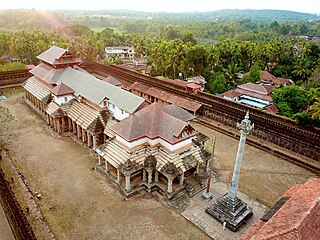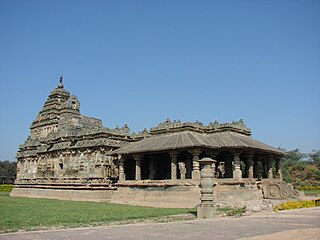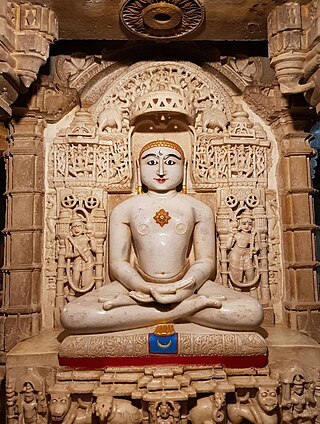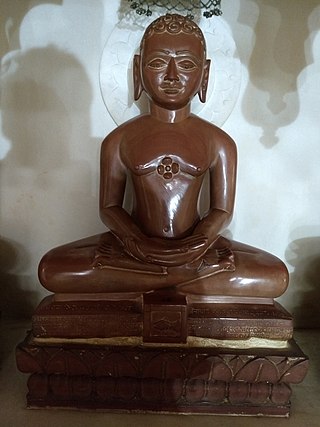
Lakshmeshwara is a town, and newly created Taluk place along with Gajendragad in Gadag district, in the Indian state of Karnataka. It is about 40 km from Gadag and 55 km from Hubli. It is an agricultural trading town. Lakshmeshwara Temple dedicated to Shiva. There are many important temples in this historic town, including the other Shiva temple, the Someshwara Temple. There are two ancient Jain temples in the town, as well as a notable Jamma Masjid. Lakshmeshwara is also home for many smaller shrines, a dargah, the Kodiyellamma temple, the Mukha Basavanna shrine, and a gigantic idol of Suryanarayana.

MoodabidriMūḍubidire; also called Mudbidri, Moodbidre and Bedra), is a town and taluk in Dakshina Kannada district. It lies 34 km northeast of the district headquarters, Mangalore, in Karnataka, India.

Mallinatha was the 19th tīrthaṅkara "ford-maker" of the present avasarpiṇī age in Jainism. Jain texts indicate Mālliṇātha was born at Mithila into the Ikshvaku dynasty to King Kumbha and Queen Prajnavati. Tīrthaṅkara Māllīnātha lived for over 56,000 years, out of which 54,800 years less six days, was with omniscience.

Munisuvrata(Munisuvrat/Munisuvratnath) was the twentieth tirthankara of the present half time cycle (avasarpini) in Jain cosmology. He became a siddha, a liberated soul which has destroyed all of his karma. Events of the Jaina version of Ramayana are placed at the time of Munisuvrata. Munisuvrata lived for over 30,000 years. His chief apostle (gaṇadhara) was sage Malli Svāmi.

Neminātha, also known as Nemi and Ariṣṭanemi, is the twenty-second Tīrthaṅkara of Jainism in the present age. Neminatha lived 81,000 years before the 23rd Tirthankara Parshvanatha. According to traditional accounts, he was born to King Samudravijaya and Queen Shivadevi of the Yadu dynasty in the north Indian city of Sauripura. His birth date was the fifth day of Shravana Shukla of the Jain calendar. Krishna, who was the 9th and last Jain Vasudev, was his first cousin.

Karnataka, a state in South India has a long association with Jainism, a religion which enjoyed patronage of major historic kingdoms in the state such as the Rastrakuta Dynasty, Western Ganga, Kadamba and Chalukya dynasties and the Hoysala Empire. Today the state is home to a number of Jain monuments, such as temples, Gommata statues and stambhas.

Saavira Kambada Temple or Tribhuvana Tilaka Cūḍāmaṇi), is a basadi or Jain temple noted for its 1000 pillars in Moodabidri, Karnataka, India. The temple is also known as "Chandranatha Temple" since it honours the tirthankara Chandraprabha, whose eight-foot idol is worshipped in the shrine.

Karkala, also known as Karla in Tulu language, is a town and the headquarters of Karkala taluk in the Udupi district of Karnataka, India. Located about 60 km from Mangalore in the Tulu Nadu region of the state,it lies near the foothills of the Western Ghats.Karkala has a number of natural and historical landmarks, and is a major tourist and transit destination due to its strategic location along the way to Hebri, Sringeri, Kalasa, Horanadu, Udupi, Kollur, Subrahmanya and Dharmasthala.

Ranakpur Jain temple or Chaturmukha Dharana Vihara is a Śvētāmbara Jain temple at Ranakpur dedicated to Tirthankara Rishabhanatha. The temple is located in a village of Ranakpur near Sadri town in the Pali district of Rajasthan.

The Brahma Jinalaya, sometimes called as the Greater Jain Temple of Lakkundi, is an early 11th-century Mahavira temple in Lakkundi, Gadag District of Karnataka state, India. The temple is attributed to Attiyabbe, the wife of the local governor Dandanayaka Nagadeva. It faces east, has a mukhamandapa, a gudhamandapa and its sanctum is covered by a sur-temple style vimana superstructure. The temple is notable for its reliefs depicting Jaina artwork, statues of the Tirthankaras and the two Hindu statues of Brahma and Saraswati inside its inner mandapa.

Chandraprabha or Chandranatha is the eighth Tirthankara of Tīrthaṅkara of Jainism in the present age. According to traditional accounts, he was born to King Mahasena and Queen Lakshmana Devi at Chandrapuri to the Ikshvaku dynasty. According to Jain texts, his birth-date was the twelfth day of the Posh Krishna month of the Indian calendar. He is said to have become a siddha, a liberated soul which has destroyed all of its karma.

Aranath(Arnath) was the eighteenth Jain Tirthankar of the present half cycle of time (Avasarpini). He was also the eighth Chakravartin and thirteenth Kamadeva. According to Jain beliefs, he was born around 16,585,000 BCE. He became a siddha i.e. a liberated soul which has destroyed all of its karmas. Aranath was born to King Sudarshana and Queen Devi (Mitra) at Hastinapur in the Ikshvaku dynasty. His birth date was the tenth day of the Migsar Krishna month of the Indian calendar.

Guru Basadi is a basadi or Jain temple located in Moodabidri town in the Indian state of Karnataka. The Guru basadi is the oldest amongst 18 Jain basadis in Moodabidri built in 714 CE. This temple is near the another famous Jain temple, Saavira Kambada Basadi.

Jain Basadi complex in Halebidu, Hassan district consists of three Jain Basadis dedicated to the Jain Tirthankars Parshvanatha, Shantinatha and Adinatha. The complex is situated near Kedareshwara temple and Dwarasamudra lake. These temples were constructed in the 12th century during the reign of Hoysala Empire along with Kedareshwara temple and Hoysaleswara Temple have been proposed to be listed under UNESCO World Heritage Site. The temple complex also includes a step well called Hulikere Kalyani.

Kere Basadi or Chaturmukha Basadi is a Jain temple located in Varanga village in Udupi district of Karnataka, India. This 12th-century temple is situated amidst of a lake giving it the name Kere Basadi. The temple is also known Chaturmukha Basadi as it houses a chaturmukha (four-faced) idol of tirthankaras. The temple is situated 26 km from Karkala, another popular Jain centre.
Panchasara Parshwanath temple is a Jain temple located in Patan, Gujarat. The temple was constructed in 8th century during the reign of Vanaraja Chavda of Chavda dynasty.

The Kumbharia Jain temples is a group of five Jain temples in the Kumbhariya, Banaskantha district in Gujarat, India. Constructed from 1062 to 1231 CE during the reign of the Chaulukya dynasty, they are noted for their elaborate architecture.

The Humcha Jain temples or Humcha basadis are a group of temples found in Humcha village of Shimoga district in Karnataka, India. They were constructed in the 7th century CE in the period of the Santara dynasty and are regarded as one of the major Jain centres of Karnataka. The Padmavati Basadi is the most well-known of these temples.

The Lakshmeshwara Jain temples is a group of Jain temples in the town of Lakshmeshwara in the Gadag district of Karnataka.

Bhandara Basadi or Chaturvimsati Tirthankar Basadi is a Jain temple (basadi) built in located in Shravanabelagola, a town in Karnataka, India.




















